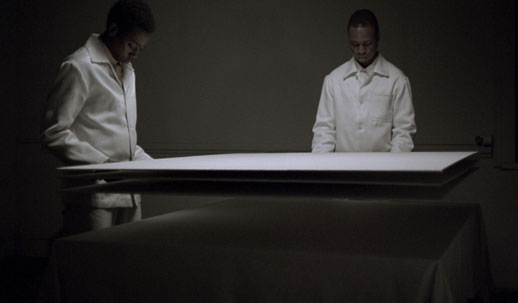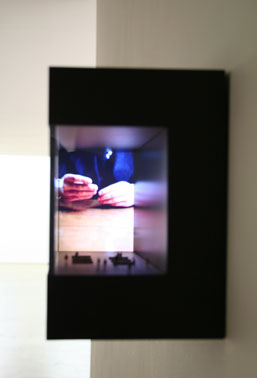A Parallel Universe of Unidentifiable Time and Space
Michaël Borremans was born in 1963 in Geraardsbergen, Belgium. He first came to attention in 1996, with his speaking busts of historical figures and series of enigmatic drawings featuring severed heads, works of Big Brother-like scenes in retro, yet futuristic, settings. Trained as an etcher, his technical skills and attention to detail give his work an underpinning of craftsmanship. He has had solo shows in Europe and America, and in 2005 exhibited a film installation at the Berlin Biennale.

His latest work is exhibited at Gallery Koyanagi in Ginza. The show contains a variety of film, oil paintings and a small mixed media piece. “Earthlight Room”, the show’s title, suggests an ethereal narrative – a quality that is evident in his work, which often focuses on the human figure engaging in mysterious activity.

The paintings are well executed with a relatively mute palette of greys, beige and a pale yellow. His use of lighting is reminiscent of Caravaggio but the piece that seems to work particularly well in this context is the small box installation The German. Inside, miniature figures sit or stand facing a screen; on the screen a suited man sequentially moves his hands. The piece relates to earlier drawings in which the figure’s hands are covered in small red dots. In this piece and the drawings series the sense of scale is disconcerting, as we become like a large Big Brother watching the small figures, who stand as if hypnotized. We can choose to identify with a kind of omnipresent disembodied eye or the figures, who, like city commuters in Tokyo, are often dwarfed by large mesmerizing screens.
Borremans’s oeuvre is quietly disturbing and has a quality that you will remember well after leaving the gallery. The complexity of his work lies in the balance between hinting at meaning, but ultimately withholding any. Viewers will enjoy the quality of the work, which, like a Japanese koan, leaves you with more questions than answers.
Rachel Carvosso
Rachel Carvosso


